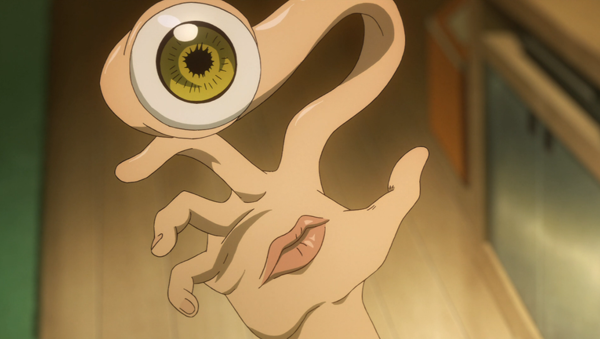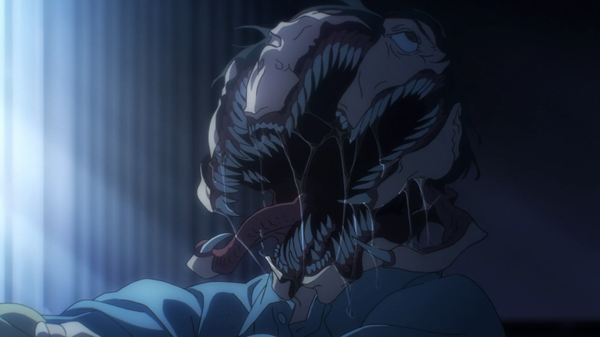When we finally meet a sentient alien species, will it be on our terms? Will we be alike? Or will we be so different as to find the very idea of each other grotesque? Perhaps the most important part of this question is whether we will be the ones finding them, or if they, whoever they are, will be the ones to find us.
Parasyte is another version of the story told by Invasion of the Body Snatchers or The Thing: that when extraterrestrial life finds us first, it will quietly usurp our position at the top of the food chain and every other biological throne that we take for granted … all without us ever knowing. Tiny seed pods float down from space and ride the wind around the world. Worm-like parasites emerge from these pods at night and try to sneak into people’s brains while they sleep. Once they do, the parasite gains full control of the host body and quickly studies up on human behavior, language, and whatever specific details remain of their host. You see, the first biological impulse that these parasites have once they reach maturity is that they must feed, and that they must do so by making cannibals of their host organism. In order to hunt other humans effectively, they must learn to hide in plain sight.
Shinichi is your average high school student living in a quiet Tokyo suburb. A parasite slips into his bedroom and finds the ear canal blocked by headphones. When it tries to slip up his nose, Shinichi wakes up, sneezing it out and panicking when he sees it. In desperation, the parasite burrows into his right hand and tries to travel up the arm, but Shinichi quickly ties it off with the headphone wires. When his parents enter his room to investigate the commotion, the hole in his hand and the wriggling bump under his skin have disappeared. Everyone writes it off as an odd nightmare. Unfortunately for Shinichi, the parasite reveals itself the next day. Sprouting an eyeball and a full-lipped mouth from his right hand, a creepy-cute voice calmly tells him that it has eaten his right arm and replaced it with a facsimile: itself.
Parasyte is an adaptation of the revered manga series of the same name, animated by Studio MADHOUSE, a respected, big name hitmaker. Series director Kenichi Shimizu and every artist involved want to make it emphatically clear from the outset that Parasyte will be a macabre visual feast. Parasites use the flesh of their hosts as biological clay, and the show is filled with images that will send shivers down your spine while putting a huge grin on your face. In the very first scene of the series, a man’s face blossoms into multiple toothy mandibles and devours the head of his wife right off her shoulders. Heads split upwards like orange peels of sinew and skin, curved blades sitting at the ends of these new, whip-like appendages. A man will practice getting used to his face by cycling through its parts, shuffling facial structure underneath folds of skin. It’s like seeing Rob Bottin and Stan Winston’s body horror effects from The Thing in animated form, though thrilling and artistically impressive in their own right.
The show’s bloodier images are the its primary hook, but the entire production has been consistently imaginative, which does wonders for the show’s deeper subject matter. In a world quietly being invaded by parasites, Shinichi and his “hand” have found themselves more symbiotically attached. The parasite, later dubbed Migi (the Japanese word for “right”), requires nutrients from his bloodstream to survive. What Shinichi gets from Migi is protection. It is revealed that the parasites can detect each other, and some of them are territorially defensive. Migi’s protection makes sense in that it wants to stay alive by keeping its host alive. However, as the two begin to understand more about their codependence, they come to value the fact that they are two individuals sharing one body.
Migi starts to work with Shinichi in an attempt to understand his humanity, and Shinichi gets to borrow Migi’s power to become the virtuous example of humanity that he wants to depict, whether it’s by killing other parasites or simply standing up to a bully. Shinichi and Migi are the heart of the series and their scenes are a wonderful counterpoint to the horror that defines the rest of it. Migi comes to be defined by a whimsical mix of cuteness and creepiness, employing all of the creative body horror stuff in a softer and even light-hearted way. Migi acts as an individual entity that is connected to the bewildered Shinichi by way of a Mr. Fantastic-style stretchy arm. Shinichi will sit in bed, bemused, as Migi crawls its way around his bedroom floor, reading biology textbooks for research. In a recent episode, Migi tests the limits of their connection (to Shinichi’s dismay) by bounding around the room as a pink, dog-like quadruped with silly eye stalks. Voice actress Aya Hirano’s wonderfully squeaky, croaky monotone completes the package. Dramatic anime can come off as very one-note, but Shinichi and Migi’s dynamic provides a great deal of refreshing tonal variety, especially since it has already proven interesting in both light and heavy contexts.
Of course, it helps when you’re adapting a finished work. Parasyte ran from 1988 to 1995, and working with a series that has a clear beginning, middle, and end has given the show’s writers the ability to introduce relationships like Shinichi and Migi’s as basically fully-formed. That said, the adaptive screenwriters, led by series composition leader Shoji Yonemura, have so far done a fantastic job of taking the material and presenting it at an engagingly brisk pace. These first four episodes have been bursting with information at all the right moments. Episode 4 is the first one to feel like a slight misstep, coming off as a bit too hurried, but Parasyte is proving to be a show that is both beautiful to watch and a breeze to enjoy. The imagery, characters, and story are well-proven quantities in the beloved manga, and so far it seems like its translation to the screen has kept those superlative qualities intact. As the series moves down from the obviously higher budget of the premiere episode to a more modest one, it will be interesting to see if Shimizu and MADHOUSE can keep up the quality and pace. Still, we’ve already gotten four impressive episodes, and the surprises keep coming; it certainly looks to me like Parasyte will be one of, if not the series to watch this season.
New episodes of Parasyte are available to Crunchyroll subscribers every Wednesday, and to non-subscribers the week after.





